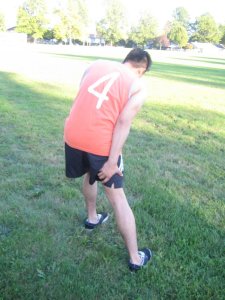Upper thigh pain occurs in the tendons, muscles, joints and also the bones found in the pelvis region. It is due to repetitive stress movements during sports and engaging in rigorous activities as well as the aging process and certain diseases. The pain can range from mild to severe. To learn to manage pain from injuries or conditions including upper thigh pain, sign up for a first aid course with a credible provider near you.
Symptoms
- Pain in the hamstrings or back part of the thigh or on the outside or inside of the quadriceps.
- A burning or numbing sensation and aching of the groin and the buttock area.
- The affected area is sensitive when touched and if pressure is applied.
- Sciatica which is pain that spreads down the leg can cause upper thigh pain.

Causes of upper thigh pain
- A condition involving compression of the lateral femoral cutaneous nerve which function in supplying sensation to the outer thigh skin and occurs in the inguinal ligament. Pressure in this area can be due to wearing tight fitting clothes, enlargement of the uterus during pregnancy, being obese and scar tissue after surgery can cause the pain.
- Burning pain in the upper thigh happens when there is inflammation or injury to the tissues. This condition is common among athletes who engage in sports involving fast movement of the joints.
- Traumatic injuries usually occur among people who are playing contact sports such as hockey and football. There is pain and tingling sensations along with swelling and difficulty in moving the leg from the thigh. Seatbelt injuries due to vehicular accidents can cause pain in the thigh.
- People suffering from diabetes where the sensory nerves of the body and the nerves found on the side of the thigh are damaged.
- Lying in a curled up position for long periods of time causes compression of the nerve which becomes irritated and inflamed, thus causing pain in the thigh area.
Treatment and home remedies
- Rest the thigh especially those who play sports in order to prevent aggravating the muscles which is the source of pain.
- Apply an ice pack or cold compress over the affected area at 20-minute intervals throughout the day. Once the swelling has subsided, apply hot compress since it promotes proper circulation in the upper thigh area.
- Wear clothes that are loose fitting in order to minimize pressure placed on the nerves and the pain disappears in a few days.
- If the individual is overweight, try to minimize weight.
- If the individual is diabetic, control the level of blood sugar and eat foods rich in multivitamins and minerals.
- Take anti-inflammatory medications such as ibuprofen and naproxen in order to lessen inflammation and pain in the upper thigh.
- The individual should perform muscle stretching exercises. These can help in increasing the mobility of the upper thigh muscles, joints and tendons while exercises for the upper thigh promotes proper blood flow in the area and quick healing of the injured area.
FACT CHECK
https://www.healthline.com/health/pain-in-upper-thigh
https://www.medicalnewstoday.com/articles/321001.php
https://www.mayoclinic.org/diseases-conditions/meralgia-paresthetica/symptoms-causes/syc-20355635
